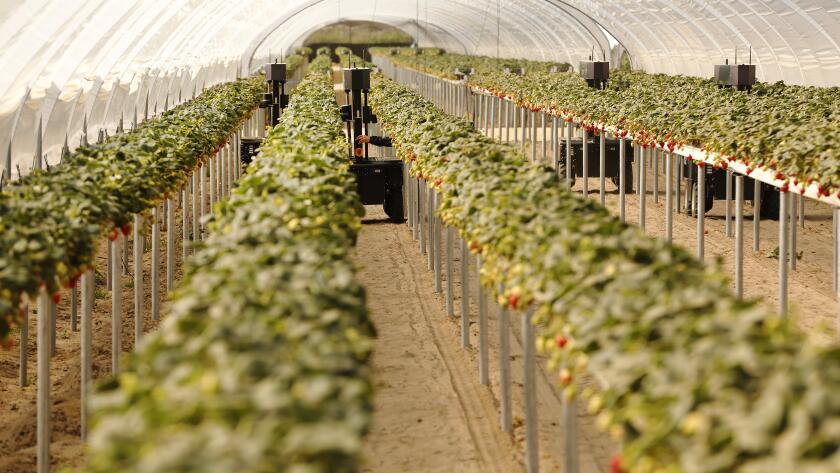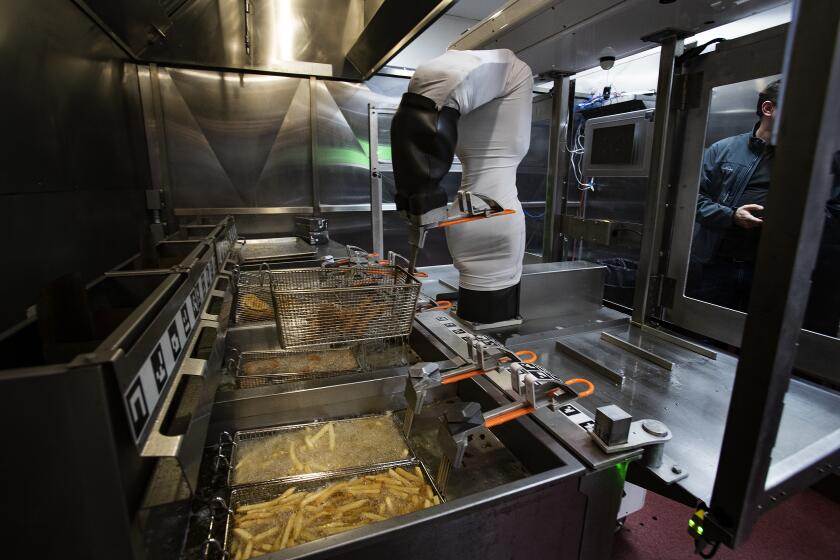California’s strawberry fields may not be forever. Could robots help?

In a strawberry field surrounded by strawberry fields on the outskirts of Santa Maria, a team of robots have been picking berries all summer.
Each robot, made by a Colorado company called Tortuga AgTech, trundles between the elevated beds on rugged wheels, then stops in front of a plant. An articulated arm maneuvers its sensor array among the leaves; machine vision software scours the sensor data in search of ripe berries.
Most California strawberry plants sprout constantly over the course of the season — little green berries sitting alongside fat red ones, nestled among the leaves. If an unripe berry is in the way, the robot repositions for a better angle. A snipper-grabber mounted in the middle of the sensors jabs in to cut the berry’s stem, then gingerly places it in a waiting plastic clamshell in a compartment at the robot’s base. The motion calls to mind a bird hunting, peering and pecking for insects.
Since hitting this field in May, the robots are on their way to picking nearly as many berries as human pickers, and with 95% accuracy, according to Tortuga. The grower paying for the work backs up that claim.
It’s getting harder to grow strawberries in California. One robotics startup is betting on a revolutionary change.
Tortuga’s pitch to growers is a subscription model that charges them a flat cost per robot-picked box of strawberries at a rate comparable to human worker wages. Unlike a human, the Tortuga bot doesn’t need breaks, can’t get sick, is always ready to work, and can pick all day and into the night. For the time being, human crews still come in after the robots for a periodic cleanup pick.
But the team behind Tortuga — and some longtime experts in California’s $2-billion strawberry industry — see agricultural robots as more than just labor-saving devices that can cut costs and boost margins for growers. They see them as the only way that an industry sitting on the intersecting fault lines of climate change, water rights, labor struggles, land use and chemical regulation can adapt and survive.
Stellar Pizza hopes to take on Domino’s and Pizza Hut with its low-labor-cost robot pizza truck.
“My whole life is now dedicated to trying to make our human systems more resilient,” said Eric Adamson, Tortuga’s co-founder and chief executive.
In the short term, he believes the company is proving that its robot is cost-effective and meets the needs of existing farms. With that proof in hand, the plan is to go to investors for a new infusion of money — the company has already raised $28 million since its founding in 2016 — and “build thousands of robots.”
In the long term, he believes that a robotic labor supply is key to a future in which the strawberry industry is no longer synonymous with the California coast, where 90% of the strawberries in the U.S. are grown.
Tortuga’s robots are designed to pick strawberries from plants grown on hydroponic tabletops, not the ground strawberries that make up almost the entirety of California’s crop. The Santa Maria location is part of a joint venture called New Wave Berry, formed by Oppy, a major fruit company based in Vancouver, Canada; Farmers Gate, an investment firm; and Red Dog Management. The venture has set up 50 of the 700 acres Red Dog manages in the area with tabletops as a pilot program, and is marketing the results under the Ocean Spray brand with “Happy Berry hydroponic strawberries” on the label.
Often protected under a plastic tunnel, tabletop systems have become popular in the Netherlands and the U.K., where Tortuga first started rolling out its robots into the field. The use of a non-soil substrate — shredded coconut husk, called coir, in the case of the Santa Maria farm — and the protection of the tunnels give growers more control, and the raised tabletop beds keep ground pests away and make harvesting less painful for workers.
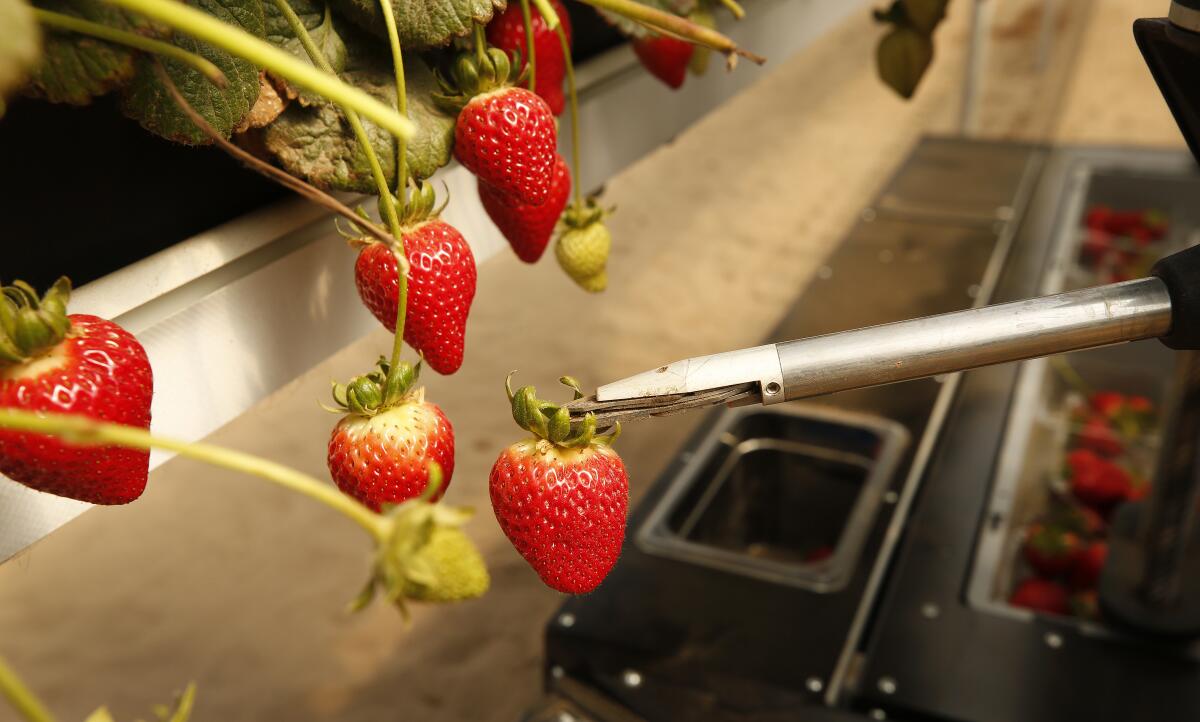
The higher cost of the tabletops has made them a rarity in California’s fields, which cover more than 30,000 acres among the three strawberry hubs of Watsonville, Santa Maria and Oxnard. Strawberries are already one of the most capital-intensive crops grown in the state, and with relatively cheap labor and ideal strawberry weather for much of the year, California growers have not felt the same pressures as their European counterparts.
But a complex mix of forces is coming to bear on the industry, making both tabletop farms and robot harvesters more viable in California. The most important shift: a changing regulatory regime for the chemicals that strawberry growers rely on.
Strawberry plants are prey to a cluster of viruses, fungi and nematodes that spread to the dirt, where they sit waiting to infect next year’s berries. Without fumigants to bomb the hostile organisms out of the soil, the pathogen load builds up over time, and subsequent crops come out withered and blighted.
Fumigation, however, is becoming increasingly regulated. Methyl bromide, once the industry favorite, was banned more than a decade ago for its effect on the ozone layer, and has also been identified as a neurotoxin and respiratory irritant. The use of chloropicrin, a common fumigant first used as a chemical weapon, is increasingly limited by buffer zones, which require growers to leave a certain distance between treated fields and roads, houses and bodies of water. And 1,3-dichloropropene, commonly referred to by the brand name Telone, is a known carcinogen and subject to strict annual usage limits in California.
At the same time their use is being scrutinized, the fumigants appear to be losing effectiveness in combating both old and new threats to strawberries that have emerged in recent years, as UC Santa Cruz professor Julie Guthman outlined in “Wilted,” her 2019 book on fumigants and the California strawberry industry.
Robotic arms like Flippy from Miso Robotics are getting cheap enough to make financial sense for low-wage work. But there’s an argument in the industry.
“There’s a general sense that fumigants aren’t long for this world,” Guthman said. “They’re very old, nasty chemicals.”
The shift in the chemical regime has made tabletop farms more appealing, even though they cost more money to install. Instead of trying to fumigate away the dangers lurking in the soil each year, growers can throw out last year’s substrate and put in a new batch.
The better ergonomics of the tabletop system also make it easier to recruit experienced harvest laborers who might otherwise pick blackberries or raspberries, which are grown in tall bushes.
On average, California growers pay more than $35,000 per acre per year in wages to the workers who pick their strawberries. That amounts to 40% of the total costs per acre for a strawberry operation, according to the most recent 2021 cost study from the University of California, and those numbers have probably risen as new state wage and overtime laws went into effect in 2022.
California growers have had a harder time attracting harvest labor in recent years, and inflation and a tight labor market have spurred workers across the state to demand higher wages. Some growers rely on workers brought in under the H-2A guest worker program, which ensures a stable workforce but drives costs higher, as the conditions of the visa require employers to provide housing, food and a minimum wage of $17.51 for 2022. With wages making up so much of a grower’s outlay, the allure of a robot’s increased reliability and potential to become more cost-efficient over time is hard to resist.
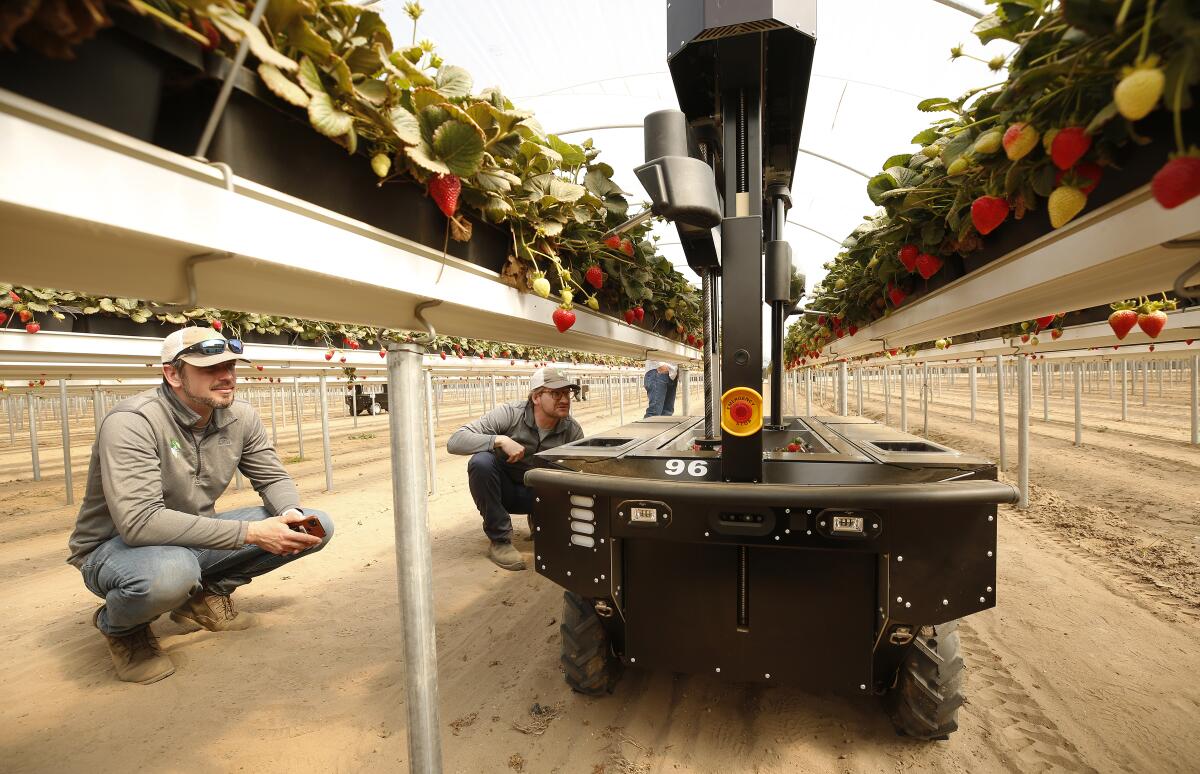
The tabletop system enables Tortuga’s strawberry bots to ply their trade by making berries easier to pluck with robotic arms and protecting the robots from direct exposure to the elements. “We want to accelerate the adoption of tabletop and controlled-environment growing, and help these farms succeed,” Adamson said. “Robots help those farms to be more economically effective, and free up more capital to put in the setup.”
Ryan Harrison, vice president and general manager at Red Dog, the company managing the Santa Maria farm, sees tabletops and robotic harvesting as key components of an even more dramatic shift for the industry, which could knock California off its spot as the strawberry king.
In coming decades, he predicted, the state’s three major growing regions will cease to be viable for outdoor cultivation as average temperatures rise, droughts lengthen, water use becomes more restricted and development drives land prices up and extends buffer zones farther into fields.
Of the three major strawberry regions, he predicted that Santa Maria is likely to hold out longest, with a moderate climate, stable water rights and a greater distance from major urban centers. “Santa Maria will be one of the last growing areas in California before everything probably goes glasshouse or indoor in places like Detroit or Chicago or New Jersey,” Harrison said. “Looking into the crystal ball, that’s going to be 20, 30 years from now.”
But California’s current dominance rests on a workforce of tens of thousands of skilled pickers. A shift to growing strawberries indoors or under tunnels on the outskirts of major U.S. metro areas would require a new workforce to match.
That’s where the robots come into play. “Once you develop a system where you can grow anywhere, you don’t care about the soil, you don’t care about the climate much, and it works in other locales in very similar ways with the same robots, you can do all this cool stuff,” said Tim Brackbill, Tortuga’s other co-founder and its chief technology officer.
“‘Sustainability’ is a nice word, but it’s becoming more of an imperative,” Adamson said. “We have to be able to grow food in a more resilient and more adaptive way, because the fires aren’t gonna stop in the American West, the water’s not going to all of a sudden come back.”
Chemotherapy and radiation can cause too much collateral damage to treat some brain tumors. Crumb-sized robots could be the solution.
Outside the crystal ball, however, there are still billions of strawberries growing in California and a number of hurdles to overcome before a robotic, hydroponic, distributed strawberry system can take root.
Mark Bolda, the director of the University of California’s Santa Cruz County Cooperative Extension and a berry specialist, agrees that California strawberries face a number of challenges — but is skeptical that the economics for tabletop farms picked by robots add up, or that the state’s industry is going anywhere.
Tabletop adoption so far has been limited, Bolda said, though he has seen experimentation. With the new fumigant regime, he said, “it’s getting iffy and we’re starting to see a lot more disease, so larger companies are trying to grow their competence in tabletops, but not at scale.”
When he co-authored UC’s latest cost study on strawberries, he looked at a hydroponic system growing in plastic-lined furrows in the ground, rather than the more expensive tabletops, and found that the economics were “a disaster.” In an average field, the costs added up to $45,000 per acre each year, excluding harvest labor. In the hydroponic system, those same costs more than doubled to over $100,000.
Harrison at Red Dog declined to share detailed cost information but said that while the cost per acre of their tabletop grow is higher than that of a traditional field, the higher yields from the tabletops make the economics work. “We produce so much more,” Harrison said — up to 50% more strawberries per acre — “that the cost per unit produced is actually less.”
“I’ve had some growers tell me that the costs are a little less” than the hydroponic setup he examined in the study, Bolda said, and noted that younger growers, a minority in an industry where he estimates the average age to be “around 60,” are more enthusiastic about trying new technologies. “I’ve been lectured by some of the younger set that I really need to up my game” and get on board with tabletop growing, Bolda said, “but the finances to me are disturbing.”
He admitted that the grow-anywhere vision of a robot-powered operation was “really intriguing,” but doubts that the California strawberry system is quite so portable. “If anything, I could see a mix of tabletops and soil” developing, Bolda said, but he believes that regular dirt fields on the California coast will persist, thanks to the climate and industry concentration, as more nuanced and targeted soil pest management replaces the old fumigation system.
In the Santa Maria test field, Tortuga’s robot fleet has already shown signs of improvement. Harrison said the company plans to extend its commercial trial at Red Dog into next year and expand its acreage.
One of Tortuga’s biggest bottlenecks now is, ironically, human labor. “If a robot has an issue, it might take us four hours to fix it, but half of that time is just waiting for someone to get to it,” Adamson said. A potential solution: retraining harvest workers as robot operators and mechanics. One picker in Santa Maria is already receiving such training.
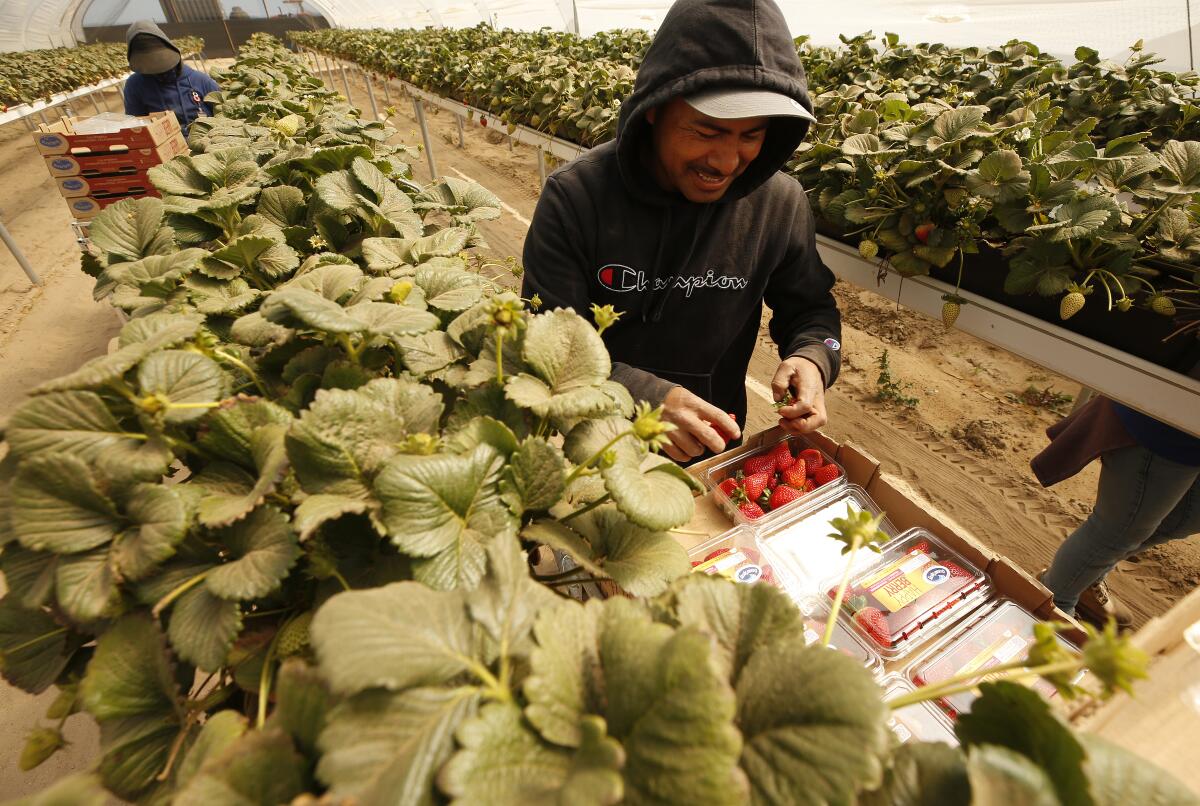
While the humans learn to work on robots, the robots are learning to work more like humans. Adamson said that a midsummer software update doubled their pick speed. “We’re basically going as fast as a slow human, but quality is really high, and we think we can get faster and faster,” he said. Tortuga’s founders expect their robots will match human output in the near future, by dint of working longer hours at a slower rate, and hit human pick speed “within a year or two.”
“I do think we’re gonna get to pretty good human speed, though I do think the best humans are going to be able to outperform robots at these judgment-driven tasks,” Adamson added. “But that’s OK. It doesn’t have to be better than every human, it just has to be better than enough people.”
More to Read
Inside the business of entertainment
The Wide Shot brings you news, analysis and insights on everything from streaming wars to production — and what it all means for the future.
You may occasionally receive promotional content from the Los Angeles Times.
